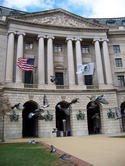On December 9, President Obama signed into law the Telework Enhancement Act, a bill designed to increase telework among federal employees. Sponsored by Representatives John Sarbanes (D-MD), Frank Wolf (R-VA) and Gerry Connolly (D-VA), the legislation gives federal agencies six months to establish a telework policy, determine which employees are eligible to telework, and notify employees of their eligibility. read more »
Environment
Dallas: Building America's Largest Urban Park on the Trinity Riverside
A flood protection site in Dallas is being transformed into America’s largest urban park. The economic and ecological benefits of conserving this slice of North Texas are destined to reverberate well beyond the city limits. Blackland Prairie is the most endangered large ecosystem in North America. The development that is underway —thankfully — to preserve this remnant of our past will also shore up our natural assets for the future. read more »
How Liberalism Self-destructed
Democrats are still looking for explanations for their stunning rejection in the midterms — citing everything from voting rights violations and Middle America’s racist orientation to Americans’ inability to perceive the underlying genius of President Barack Obama’s economic policy.
What they have failed to consider is the albatross of contemporary liberalism. read more »
A Price on Carbon: the New Greenmail
Hidden from view during the Australian election, a carbon price is back on the political agenda. This comes as no surprise. Anyone following the debate, however, will see that it has nothing to do with the environment. For some time we have been urged to “act now”, but the grounds keep shifting and changing. Early on it was the drought. Then the Great Barrier Reef. After that the Bali Conference. Then the election of Barack Obama. Next came the Copenhagen Conference. Then being “left behind” in clean technology. Now, apparently, “inaction will cost more in the end”. read more »
Environmental Consequences of Low Fertility Rates
But isn’t it great news for the environment that we are having fewer children?”
We should always stress the positive in life. Were it not for the dramatic slowdown in birthrates that began the late 1960s and 70s, the apocalyptic warnings of overpopulation then voiced Paul Ehrlich, the Club of Rome, and many others could well have come true in short order. We are lucky that they did not. But it is not clear the “the planet” is any better off as a consequence. read more »
The EPA: Leading Into A Rain Garden?
Newly-installed solar Panels on the White House are an obvious signal that this administration wants to lead by example. Conservatives will no doubt find ways to ridicule the panels, and liberals will praise them as a display to the world that we are a green nation. About one year ago, on Oct. 5, 2009, the President signed Executive Order (EO) 13514, “Federal Leadership in Environmental, Energy, and Economic Performance.” Like the white house solar panels, this EO also is intended to urge federal agencies to lead by example. read more »
Green Jobs for Janitors: How Neoliberals and Green Keynesians Wrecked Obama's Promise of a Clean Energy Economy
In August 2008, then-candidate Barack Obama traveled to Lansing, Michigan, to lay out an ambitious ten-year plan for revitalizing, and fundamentally altering, the American economy. His administration, he vowed, would midwife new clean-energy industries, reduce dependence on foreign oil, and create five million green jobs. "Will America watch as the clean-energy jobs and industries of the future flourish in countries like Spain, Japan, or Germany?" Obama asked. "Or will we create them here, in the greatest country on earth, with the most talented, productive workers in the world?" read more »
Environmentalism as Religion
Traditional religion is having a tough time in parts of the world. Majorities in most European countries have told Gallup pollsters in the last few years that religion does not “occupy an important place” in their lives. Across Europe, Judeo-Christian church attendance is down, as is adherence to religious prohibitions such as those against out-of-wedlock births. And while Americans remain, on average, much more devout than Europeans, there are demographic and regional pockets in this country that resemble Europe in their religious beliefs and practices. read more »
Fortress Australia: Groundhog Day
A decade ago, politics in Australia lurched to embrace all things rural, happily demonizing urban interests. This happened in response to a renegade Politician – Pauline Hanson – who for a time captured public sympathy with populist anti-immigration sentiments, threatening to unseat entire governments in the process. read more »
A Pill For Los Angeles? Medicating the Megacities
Los Angeles — and other modern megacities — conjure increasingly unique genetic profiles that point the way to a new medical industry: Call it urbo-pharmaceuticals. Investors are needed.
Is there a pill that might inoculate us from smog?
Is there a gene we can target that would make us resistant to resurgent infectious diseases?
And is there a way to use genetic data to insulate new immigrants from some of the metabolic challenges of living in a new land of plenty?
Welcome to the slowly emerging world of environmental medicine and its inevitable outgrowth, environmental pharmaceuticals: compounds specifically suited for mitigating the physiological challenges of mega-city life in the 21st century. read more »






















